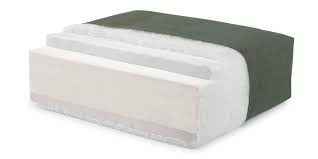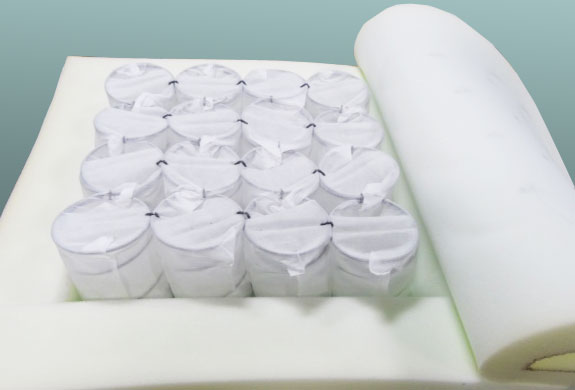Question:
My last sofa cost nearly $3000. The cushions sagged and felt uncomfortable after less than 3 years. We lived with that sofa for another 3 years with the cushions looking and feeling worse as time went on.
It’s time to get a new sofa. This time I want one with much better cushions that are more comfortable and don’t wear out so quickly.
What type of cushions should I get? What do I need to avoid?
Answer:
This is not a simple question.
My answer will take you step by step through multiple cushion constructions.
It will include cost considerations, quality analysis, and what determines how long a cushion will last.
Along the way, it will fill in important details that salespeople and product descriptions omit, beginning with the difference between density and firmness.
Most sofa shoppers confuse “firmness and density.”
Foam firmness changes over time.
Foam density does not change over time.
Higher foam densities last longer.
A 2.5 density foam cushion will last at least twice as long as a 1.8 density foam cushion.
When a couch is new in the showroom, 1.8 and 2.5 density cushions will feel almost identical.
1 year later, the 1.8 density cushion will be noticeably softer.
The 2.5 density cushion will still feel brand new.
5 years later, the 1.8 density cushions may be uncomfortably soft.
The 2.5 density cushions will have lost very little of their original firmness.
Higher density foam costs more.
The higher the density, the higher the cost.
When a foam is described as “high density” or “high resiliency” without any number, it almost always refers to 1.8 density foam.
Firmness does not affect the foam’s cost.
For each foam density, extra-firm, medium firm and gently firm all cost about the same.
The terms “high density” and “high resiliency” are often used interchangeably.
But when a manufacturer buys foam, the difference is very clear.
A foam supplier may stock foam in 10 different densities.
The higher the density, the more the foam will cost.
There is also a fabricating process which can make foam more “resilient.”
This means it will “bounce back” better after being sat upon.
High resiliency is a desirable trait for sofa cushions. The additional cost is minimal.
As a result, most “high density” foam is also “high resiliency,” whether or not the term “high resiliency” is used anywhere in the marketing description.
Foam seat cushions are usually fabricated with a “wrapping” around the foam.
In most seat cushions, the wrapping is a layer of dacron polyester fiber.
The fiber comes in sheets that are usually 1″ to 1.5″ thick.
The fiber wrapping covers the top, bottom and sides of the cushion.
Some cushions use fiber wrappings up to 3″ thick.
These thicker wrappings puff up the thickness of the cushions and make them look great in the showroom.
But the thicker fiber wrapping can compress within the first year, leaving cushions that look lumpy and worn out.
In mid-range and high-end cushions, wrapped cushions are almost always sewn into a fabric cover.
This keeps the foam and fiber from shifting.

Foam cushion with fiber wrapping
Foam seat cushions may also have alternative wrappings.
Some of the most common alternative wrappings include:
Down blend (usually feathers and fiber without any down.)
Down and feathers (usually with 5% down or less.)
These alternative wrappings do not add any extra durability to the cushion’s lifespan.
“Down-wrapped” seat cushions refers to the down and feather alternative listed above.
Down-wrapping is never “all-down.”
The majority of the wrapping will be feathers.
All of the alternative wrappings listed above are enclosed in a down-proof fabric ticking cover.
Memory foam cushions.Most salespeople (and product descriptions) imply that “Memory gel” cushions are completely made with memory foam.
That is not true! I have never seen a sofa cushion that has a solid memory foam core.
“Memory gel foam” refers to the thin sheet that replaces the dacron fiber wrapping around the polyurethane core.
The memory gel wrapper adds a slight amount of extra durability.
A memory gel wrapper may make the cushion feel softer and hold its shape better over time.
Cushion size affects its lifespan.
Larger cushions (with more surface area) will last longer than smaller cushion with the same foam density and thickness.
The larger surface area spreads out the weight of the sitter, reducing the maximum pressure placed on the foam.
Your weight (and the amount of use) also affects cushion lifespan.
The average lifespans listed above are for people who weigh less than 200 lbs.
Cushion lifespan will decrease when used by larger individuals. For example:
A 1.8 density foam cushion, with a core thickness of 5″, on a three seat average size sofa, should last 5 years when used by an individual weighing 180 lbs.
A 250 lb. person sitting on that same cushion may decrease the lifespan to only 3 years.
A 300 lb. person sitting on the same cushion may decrease the lifespan to less than 1 year.
A 2.5 density foam cushion, with a core thickness of 5″, on a three seat average size sofa, should last 15 years when used by an individual weighing 180 lbs.
A 250 lb. person sitting on that same cushion may decrease the lifespan to less than 10 years.
A 300 lb. person sitting on the same cushion may decrease the lifespan to 5 years.
Increasing the surface area or the thickness of the cushions will increase the lifespan from the estimates given above.
Why is it so hard to find 2.5 density foam cushions?
Mid-range upholstered furniture is highly competitive.
Furniture store buyers are well aware that certain “price points” are important for high-volume sales.
For example, a sofa priced at $2019 may have significantly lower sales than the same sofa priced at $1999.
Paying an additional $10 to the manufacturer may result in a couch missing an important “price point.”
Increasing the foam density from 1.8 to 2.5 can increase the retail price of a couch by $200.
In the showroom, both brand new couches would look and feel identical.
A good salesperson could point out that the more expensive couch will last twice as long.
But most salespeople aren’t that good.
It is easier for them to sell the less expensive couch.
The furniture store’s buyers know that the cheaper sofa selling for $200 less will outsell the more expensive alternative.
An added benefit is that the customer may be back for another couch in 5 years.
After selling the higher priced couch, the customer probably won’t return for at least 10 years.
Spring Down (or Spring Fiber) cushions also last far longer than 1.8 density foam.
These will cost even more than 2.5 density foam cushions.
For most people, including larger individuals, these cushions should last 15+ years with minimal loss of firmness or comfort.

Spring down and Spring Fiber cushions have a foam border, surrounding fabric wrapped coil springs.
Spring Down cushions add a fabric down-proof jacket filled with down and feathers above and below the foam and coil springs.
Spring Fiber cushions substitute less expensive polyester fiber for the down and feathers.
Alternative “Down Blend” cushions specifications combining feathers and polyester are also popular.
Down is, by far, the most expensive filling.
Most Spring Down cushions use only 5% Down.
Down has the softest feel and the most “loft.”

Down cushions, without any foam, are sometimes found in expensive traditional style couches.
These are far more expensive than foam or Spring Down cushions.
The sofa cost can vary by hundreds (or thousands) of dollars, depending on the amount and quality of the down.
Most “down cushions” are only 25% or 50% down.
Less expensive feathers are used for the majority of the filling.
It is not unusual for the down percentage to be only 10 – 15%.
Down and feather cushions have very little “resiliency” (the ability to bounce back after use.)
It is necessary to “fluff” up the cushions after each use.
Down and feather cushions are almost always found with 8-way hand tied foundations only.
Feathers are far less expensive than down, but more expensive than polyester fiber.
Polyester fiber is less expensive than feathers.
The difference in comfort and resiliency between feathers and fiber is minimal.
“Down Blend” cushions often do not have any down at all. They may be a combination of feathers and fiber only.
Check out the Fiber Down cushon below with 50% Feathers, 50% Fiber and 0% Down.

If you like my Insider’s Guide To Furniture please encourage your friends and family to check it out.
My 45 years in the furniture industry have provided me with a detailed knowledge of furniture brands, construction, quality & value.
Over the past decade, I have written over 2,000 articles, reviews, and answers, seen by over 2 million viewers.
If any company or individual feels that the information on this website is out-of-date or inaccurate, please let me know and it will be promptly corrected.
Important Note about advertising on this website:
I do not solicit or accept payment from any of the brands reviewed or mentioned on InsidersGuideToFurniture.com.
Despite this, you may see ads on the website. These ads are generated by Ezoic.
Ezoic is a Google platform for website publishers. It is completely automated!
I do not have contact with any of the companies or agencies that choose to advertise on this website through Ezoic.

Hi Jeff,
I find your blog to be very helpful. My nephew wants to replace his sofa because the cushions are wearing down. I’m trying to direct him to some advice I’ve read of yours here, especially regarding 2.5 density foam vs 1.8. I know I’ve bought sofas in the past myself that haven’t held up. Can you provide a list of some manufacturers who use 2.5 density foam, & otherwise make a very reliable product?
This is going to depend on your budget.
2.5 density foam cushions should hold up for 10+ years if your nephew weighs 200 lbs. or less.
Spring Down cushions cost only a little more and will hold up 15+ years.
These cushion options are not usually found in mass produced furniture.
Custom-built sofas that have these long lasting cushion options will usually cost at least $2500.
If that is out of your price range, you should be able to get 2.5 density foam replacement cores for your current sofa.
You may be able to get replacement cores at a local upholstery shop.
There are also a couple of online custom cushion makers selling replacement cushions with densities of 2.5 – 2.9.
Foamorder.com
The Foam Factory
Another alternative if your budget is below $2500, is to look for sofas with larger seat cushions.
When seat cushions have larger surface areas, there is less pressure per square inch when you sit down.
Large 1.8 density cushions will last longer than smaller size cushions.